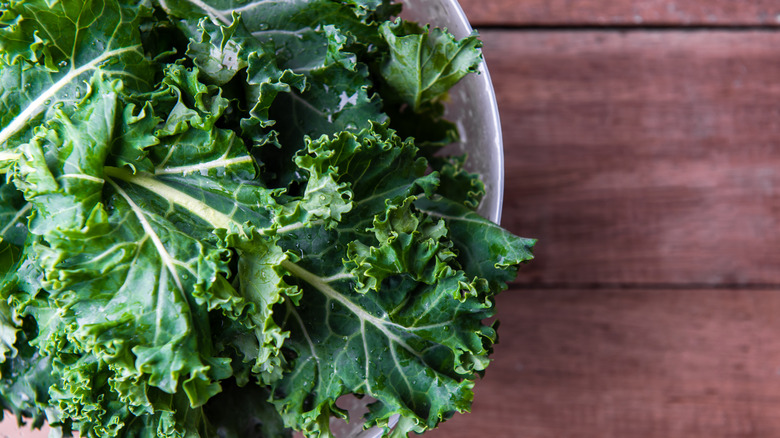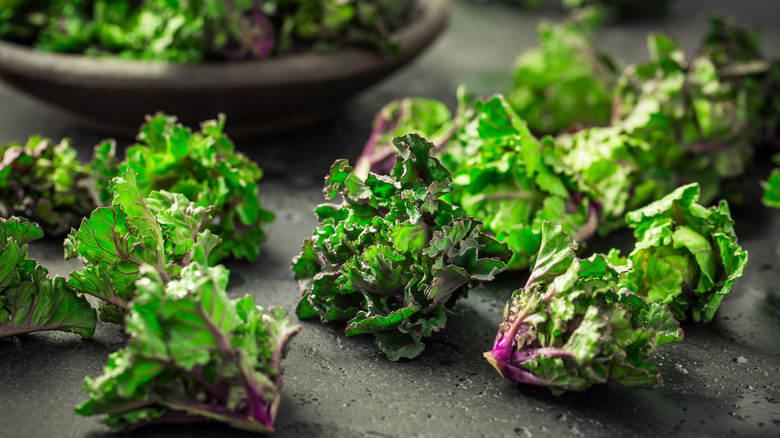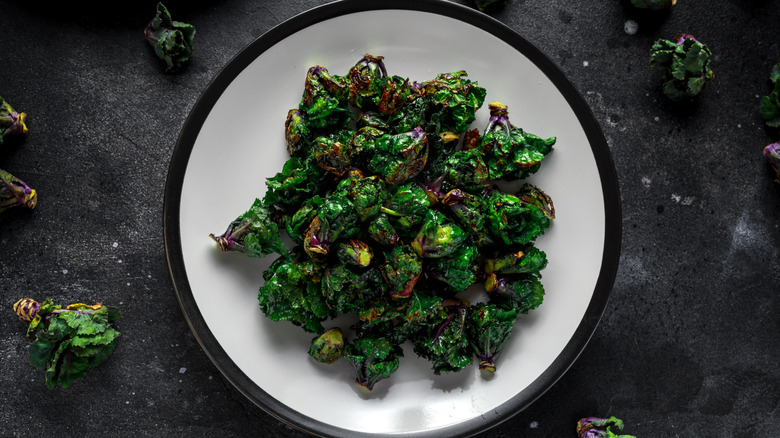Kale Vs. Kalettes: What's The Difference?
Kalettes, also known as flower sprouts, lollipop kale, or kale sprouts, are the cool new kids in the vegetable world that are quickly stealing the spotlight from their parents. A cross between two superfoods, kale and Brussels sprouts (we'll get into the science later), kalettes combine the best traits of both: Their delicate, ruffled leaves and compact, flower-like shape make them visually appealing while their mild, sweet flavor sets them apart from the earthiness of kale or the bitterness of Brussels sprouts.
While kale is the bright and bold powerhouse we all know and love, it does come with its challenges — blanching, de-stemming, or massaging the leaves are often needed to tame its tougher texture, especially for salads — and while fats like avocado make a massaged-kale salad, it's extra work. Kalettes, on the other hand, provide a much more tender texture straight out of the bag, making them a great choice for a busy weeknight dinner or Sunday meal prep.
Both kalettes and kale are packed with vitamins, fiber, and antioxidants, so you're getting a nutritional punch either way. You can roast them, saute them, or include them in a salad, just like kale, with less of the prep time.
The science behind how kalettes came to be
Kalettes are like the produce-aisle version of a superhero origin story, created by the clever minds at U.K.-based company Tozer Seeds. While the ancestors of kale were enjoyed by the Ancient Greeks and Romans, kalettes are still babies in the vegetable world, having only just made their first appearance on shelves in 2010. These little guys are a hybrid, born by breeders carefully selecting traits from both parents until the perfect little veggie Frankenstein was sprouted.
The process behind this crossbreeding is a bit like matchmaking for plants — via good old-fashioned selective reproduction. Over more than a decade, breeders focused on selecting traits like kale's vibrant frilly leaves and Brussels sprouts' compact, stalk-growing habit. The goal was to create a vegetable that balances the nuttiness of sprouts with the milder, sweeter flavor of young kale.
And the result? A vegetable that's as cute as a button (hello, adorable baby cabbage!) but with a much more gentle flavor. These tiny, colorful greens grow on stalks like sprouts but rock the bright frilly leaves we associate with kale. They are harvested in the cooler fall and winter months and grow in eye-catching green or purple shades that are as packed with benefits as they are with unique personalities.
How kale and kalettes stack up in the kitchen
Here's where the science gets interesting: Kalettes, kale, and sprouts may share a family tree, but their flavors, textures, and how they're cooked are all pretty different. Kale is known for its bold, grassy flavor due to the glucosinolates it contains, which can be intense. The plant is even hard to digest — especially when eaten raw. It's best suited for longer cooking times, which helps break down its tough fibers and mellow out the flavor — or high-heat techniques like blanching and drizzling with oil and salt, massaging with lemon juice, or baking into a warming sausage and kale pasta bake.
Brussels sprouts, on the other hand, have a similar earthy, slightly bitter flavor but are more compact and dense. They require careful cooking to avoid bitterness, often blanched before being roasted to bring out their natural sweetness. And when overcooked, they can become mushy, so they benefit from slightly shorter cooking times.
And their lovechild, kalettes, combine the best of all words: making them a great alternative for those who find kale too earthy or sprouts too bitter. Their tender texture means they cook faster than both kale and Brussels sprouts, so they're ideal for high-heat, quick methods like sauteing. And when cooked, kalettes' slightly sweet, caramelized flavor really comes out to play. They can even be eaten raw, so they work well in salads where their natural sweetness shines without the need for much preparation.



